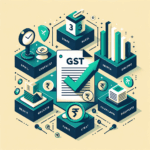GST and E-Commerce: A Complete Guide to the New Rules for Online Sellers in India
Whether you’re selling handmade crafts on Instagram, electronics on Amazon, or offering services through your own website, India’s e-commerce landscape is booming. But with great opportunity comes great responsibility—especially when it comes to taxes. As an online business owner, you must navigate the complex and ever-evolving e-commerce rules for online sellers to stay compliant and successful. The rules governing e-commerce, particularly the Goods and Services Tax (GST), have recently seen significant changes that directly impact small and medium-sized businesses. Understanding these regulations is crucial for avoiding heavy penalties, ensuring smooth operations, and maintaining a healthy business. This comprehensive guide will simplify the latest online sellers GST regulations India for both new and existing sellers, ensuring you have all the information you need to thrive.
Understanding GST for E-Commerce: The Foundation
Before diving into the new rules, it’s essential to have a solid grasp of the basics. For a broader overview, you can review the GST for E-commerce Businesses: Key Considerations. The Goods and Services Tax (GST) is the backbone of India’s indirect tax system, and for online sellers, it’s a critical component of daily operations. Failing to understand its implications can lead to serious legal and financial trouble, making a foundational knowledge non-negotiable for anyone operating in the digital marketplace.
What is GST and Why is it Critical for Online Sellers?
GST, or Goods and Services Tax, is a comprehensive, multi-stage, destination-based tax that has replaced many indirect taxes in India like excise duty, VAT, and services tax. It’s a unified tax levied on the supply of goods and services across the country. For the e-commerce sector, GST holds particular significance. Traditionally, under the old regime, GST registration was mandatory for all online sellers from the very first day of business, regardless of their annual turnover. This created a significant compliance burden for small-scale entrepreneurs and artisans looking to leverage online platforms. Proper GST compliance for e-commerce businesses is not an optional extra; it’s a legal requirement that directly impacts your product pricing, overall profitability, and the legal standing of your business. It ensures transparency, prevents tax evasion, and creates a level playing field for all sellers, big or small.
The Core Components: CGST, SGST, and IGST Explained
Understanding how GST is divided is key to correct invoicing and filing. The tax is split into three components based on the location of the seller and the buyer. This distinction determines which government body receives the tax revenue and which tax is levied on the transaction.
Here’s a simple breakdown of the three types of GST:
- CGST (Central Goods and Services Tax): This is the tax collected by the Central Government on an intra-state sale. An intra-state sale is a transaction where the location of the supplier and the place of supply (the buyer’s location) are in the same state.
- SGST (State Goods and Services Tax): This is the tax collected by the State Government on the same intra-state sale. In an intra-state transaction, both CGST and SGST are charged. For example, if the GST rate is 18%, it will be split into 9% CGST and 9% SGST.
- IGST (Integrated Goods and Services Tax): This is the tax collected by the Central Government for an inter-state sale. An inter-state sale is a transaction where the supplier and the buyer are in different states. The IGST rate is generally the sum of the CGST and SGST rates (e.g., 9% + 9% = 18% IGST).
To make this clearer, let’s look at a simple table:
| Transaction Type | Seller Location | Buyer Location | Tax Applicable | Example (18% GST Rate) |
|---|---|---|---|---|
| Intra-State Sale | Mumbai, MH | Pune, MH | CGST + SGST | 9% CGST + 9% SGST |
| Inter-State Sale | Mumbai, MH | Delhi, DL | IGST | 18% IGST |
| Sale to Union Territory | Mumbai, MH | Chandigarh, CH | IGST | 18% IGST (as UTs without legislature are treated as inter-state) |
The Game-Changer: Unpacking the New E-Commerce Rules India
The GST Council has recognized the compliance challenges faced by small online sellers and has introduced significant changes to ease their burden. This section details the shift from the old, rigid system to the new, more flexible framework, which is a major development in the e-commerce rules for online sellers.
The Old Rule: Mandatory GST Registration for Everyone
Previously, the GST law was quite strict for online sellers. Under Section 24(ix) of the CGST Act, any person supplying goods through an E-Commerce Operator (ECO) like Amazon, Flipkart, or Myntra was required to obtain GST registration, regardless of their annual turnover. This meant that even an artist selling a single painting for ₹5,000 online had to go through the entire GST registration and filing process. This acted as a major deterrent for micro-entrepreneurs, homemakers, and students who wanted to test their business ideas on a small scale without getting entangled in complex tax formalities from day one.
The BIG Update: Threshold Exemption for Small Online Sellers
The 48th GST Council meeting brought a massive relief for small businesses. Effective from 1st October 2023, a game-changing amendment was introduced. Unregistered persons can now sell goods through e-commerce operators without needing a full GST registration, provided they meet certain conditions. This is the cornerstone of the new e-commerce GST rules India.
The new turnover thresholds for this exemption are:
- Up to ₹40 lakhs for sellers of goods.
- Up to ₹20 lakhs for service providers.
(Note: These thresholds are ₹20 lakhs for goods and ₹10 lakhs for services in special category states).
However, there is a crucial condition: This exemption is only available for intra-state sales. This means you can sell goods or services only to customers located within your own state to qualify for this benefit. Sellers who are below this turnover limit and sell only within their state can now operate without a GSTIN (GST Identification Number), but they must obtain a simpler GST enrolment number. This change is designed to boost micro-commerce and bring thousands of small sellers into the formal digital economy.
Who Still Needs Mandatory GST Registration?
While the new rule is a welcome change, it’s not a blanket exemption for everyone. It is vital to understand the scenarios where GST registration remains compulsory, irrespective of your annual turnover. Misunderstanding these nuances can lead to non-compliance penalties. Our Ultimate Guide to GST Registration for Small Businesses provides further clarity on this topic. You must obtain a full GST registration if you fall into any of the following categories:
- Inter-State Sellers: The moment you decide to sell your product to a customer in another state, GST registration becomes mandatory. The turnover exemption does not apply to inter-state supplies made through an e-commerce platform.
- Turnover Exceeding the Threshold: If your aggregate annual turnover from all your business activities (both online and offline) crosses the ₹40 lakh limit for goods or the ₹20 lakh limit for services, you must register for GST.
- Specific Notified Goods: The government has specified certain goods for which GST registration is mandatory from the start. If you deal in items like ice cream, pan masala, or any tobacco and manufactured tobacco substitutes, you need to register for GST regardless of your turnover.
This clear demarcation underscores the importance of carefully evaluating your business model and adhering to the relevant e-commerce guidelines for sellers India.
Your Action Plan: A Step-by-Step Guide to GST Compliance
Knowing the rules is one thing; implementing them is another. This actionable guide will walk you through the essential steps to ensure your online business is fully compliant with the latest GST regulations, whether you need full registration or just an enrolment number.
Step 1: Assess Your GST Registration Needs
The first and most critical step is to determine whether you need a GST registration. Rushing this decision can lead to unnecessary compliance work or, worse, penalties for non-compliance. Use this simple checklist to assess your situation:
- [ ] Do you sell goods or services online through an e-commerce operator?
- [ ] Is your projected aggregate annual turnover below ₹40 lakhs (for goods) or ₹20 lakhs (for services)?
- [ ] Will you be selling only to customers located within your own state?
Guidance: If you answered ‘Yes’ to all three questions, you are likely eligible for the new exemption and can operate with just a GST enrolment number. If you answered ‘No’ to either of the last two questions—meaning your turnover exceeds the limit or you plan to sell inter-state—you must proceed with obtaining a full GST registration.
Step 2: The Registration/Enrolment Process
Once you’ve assessed your needs, the next step is to get the required credentials from the GST portal. The process differs slightly for mandatory registration versus enrolment for exempt sellers.
For Mandatory Registration:
If you need a full GSTIN, you will have to complete the formal registration process.
- Required Documents: You’ll typically need your PAN Card, Aadhaar Card, proof of business address (like an electricity bill or rent agreement), bank account details (a cancelled cheque or bank statement), and a photograph of the proprietor/partners.
- Process: The application is filed online on the official GST Portal. You will need to fill out Form GST REG-01, upload the necessary documents, and submit it for verification by a tax officer.
- Official Portal: All registrations are done through the GST Portal.
- Expert Help: The GST registration process can be tricky, with specific documentation and field requirements. To avoid errors and delays, let TaxRobo’s experts handle it for you for a seamless experience.
For Exempt Sellers:
If you qualify for the exemption, you don’t need a GSTIN, but you still need to enrol on the portal.
- Process: You must use a separate functionality on the GST portal to obtain a GST enrolment number. This involves declaring your PAN-validated business details and address. This enrolment number allows the e-commerce operator to legally host you on their platform and enables the government to track your sales.
Step 3: Understanding TCS (Tax Collected at Source)
Tax Collected at Source (TCS) is a crucial concept within the online sellers GST regulations India. It is a mechanism to track transactions and ensure tax compliance in the e-commerce ecosystem.
- What is TCS? E-commerce operators like Amazon and Flipkart are required by law to deduct a small percentage of tax, which is 1% (0.5% CGST + 0.5% SGST for intra-state sales, or 1% IGST for inter-state sales), on the net value of taxable supplies made by sellers through their platform. This deducted amount is called TCS.
- Applicability: This provision applies only to sellers who are registered under GST. Exempt sellers operating with an enrolment number are not subject to TCS deductions.
- Claiming Credit: The 1% TCS collected by the operator is not a cost to your business. It is deposited with the government against your GSTIN. You can see this amount in your electronic cash ledger on the GST portal. You can then claim this TCS amount as an Input Tax Credit (ITC) to offset your final GST liability when filing your monthly GSTR-3B return. This ensures that the money is rightfully credited back to you.
Step 4: Filing GST Returns on Time
For those with a mandatory GST registration, compliance doesn’t end with registration. Regular and accurate filing of GST returns is a legal obligation. Our How to File GST Returns Online: A Step-by-Step Guide of the GST Filing Process & Procedure offers comprehensive instructions. Timely filing is essential to avoid hefty late fees and interest penalties, and it also ensures that your customers can claim Input Tax Credit on their purchases from you, which is crucial for B2B transactions.
- Primary Returns: The two most important returns for most e-commerce sellers are:
- GSTR-1: This is a monthly or quarterly return where you declare the details of all your outward supplies (sales).
- GSTR-3B: This is a monthly summary return where you declare your total sales, ITC claimed, and pay the net tax liability.
- Importance of Deadlines: The deadlines for these returns are strict. Missing them can result in a penalty of up to ₹50 per day, per return, and can also lead to the suspension of your GST registration.
- Professional Assistance: Juggling sales, marketing, and logistics is already a huge task. Don’t let tax filing add to your stress. Stay on top of your deadlines with TaxRobo’s GST Filing Services. We ensure your returns are accurate and filed on time, every time.
Conclusion
The world of e-commerce in India is more accessible than ever, thanks to progressive changes in the tax landscape. The introduction of the turnover threshold exemption is a significant boon for small sellers, empowering them to start and grow their digital ventures with a lower compliance burden. However, it’s crucial to remember the key takeaways: the exemption is strictly for intra-state sales, and crossing the turnover limit or venturing into inter-state sales immediately requires full GST registration. Adhering to the latest E-Commerce rules for online sellers is not just about avoiding penalties; it’s about building a strong, sustainable, and legally sound business foundation.
Navigating the e-commerce guidelines for sellers India can feel overwhelming, especially with rules around TCS, return filing, and state-specific regulations. Don’t let compliance complexities slow your business down. Reach out to the experts at TaxRobo for personalized guidance on GST registration, filing, and all your business compliance needs.
Frequently Asked Questions (FAQs)
1. I sell products on Instagram only within my city, and my yearly sales are around ₹5 lakhs. Do I need a GSTIN?
Under the new e-commerce GST rules India, since your sales are below the ₹40 lakh threshold and are intra-state only (within your city), you do not need a full GST registration (GSTIN). However, to operate legally through an e-commerce platform (which social media can be considered in this context if payments are facilitated online), you will need to obtain a GST enrolment number from the portal.
2. What happens if I am an exempt seller but receive an order from another state?
The exemption for small sellers is strictly limited to intra-state supplies. The moment you decide to accept and fulfill an inter-state order, GST registration becomes mandatory for you, regardless of your turnover. You must complete the full GST registration process and obtain a GSTIN before making that supply. Selling inter-state without a GSTIN is a violation of GST law.
3. How does the 1% TCS collected by Flipkart/Amazon benefit me?
The TCS deducted by the e-commerce operator is deposited against your PAN/GSTIN with the government. This amount automatically appears in your electronic cash ledger on the GST portal. It is essentially an advance tax paid on your behalf. When you file your monthly GSTR-3B return and calculate your final GST liability, you can use this TCS amount to pay off that liability. It effectively acts as a credit, reducing your final cash outgo and ensuring that the money is not lost.
4. Are the GST rules the same for selling goods versus providing services online?
While many core principles of GST, like the need for registration for inter-state supplies and TCS provisions, are the same for both goods and services, there are key differences. The most significant one introduced recently is the turnover threshold for the exemption: it is ₹40 lakhs for sellers of goods and ₹20 lakhs for providers of services. Additionally, the ‘place of supply’ rules, which determine whether a transaction is intra-state or inter-state, can be more complex for services and depend on the nature of the service provided.



